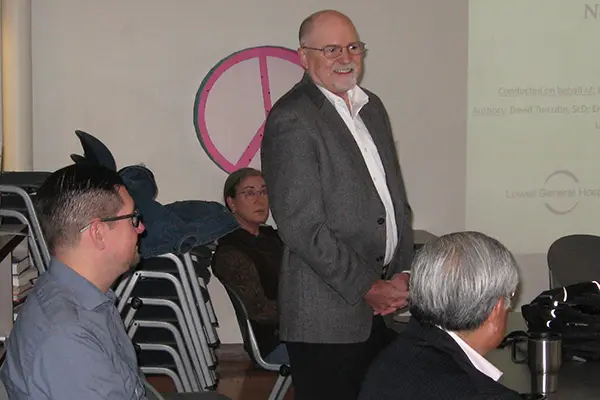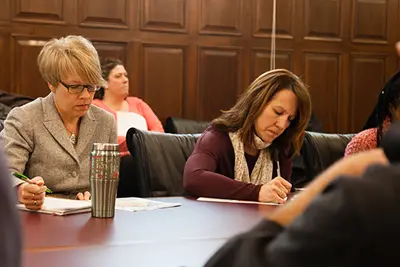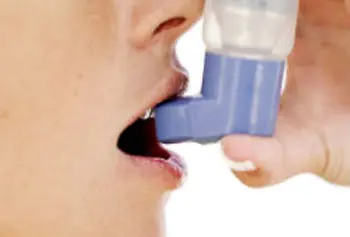Students Get Hands-on Community Health Research Experience
 Image by Katharine Webster
Image by Katharine Webster
11/10/2016
By Katharine Webster
University students and faculty researched the health needs of Lowell and surrounding towns — and found some surprises.
On most major measures of overall health — diabetes, high blood pressure, asthma and heart disease — Lowell residents, who have lower incomes and other barriers to health care, are worse off than residents of Billerica, Chelmsford, Dracut, Dunstable, Tewksbury, Tyngsboro and Westford.
But residents of the surrounding towns have higher rates of obesity and cancer than city residents, says Economics Research Prof. David Turcotte, who led the 2016 Community Health Needs Assessment. And a shortage of addiction treatment and mental health services, especially coordinated care for people suffering from both, is an areawide problem.
Lowell General Hospital, now part of Circle Health, must complete the state-mandated assessment every three years and contracted with UMass Lowell to conduct it. The assessments are done in partnership with the Greater Lowell Health Alliance and local health care executives and nonprofits use the findings to improve care and community interventions. Turcotte and students working with him through the Center for Community Research and Engagement also led the 2013 assessment.
The assessment released this fall looks at state health data, economic and housing data, interviews with key informants and issues identified by 16 focus groups: health care providers, emergency responders, nonprofits, teenagers and different patient groups, including the Cambodian, Portuguese, Brazilian, African and Latino communities.
 Image by Katharine Webster
Image by Katharine Webster
“It was really cool observing the whole process of how the community addresses health issues in a proactive way, versus solely reacting when people come into the hospital,” she says. “It’s something I wouldn’t have seen in the classroom.”
Katerin Ramirez Tejada, a doctoral candidate in global studies, says taking notes in a focus group for Spanish-speaking residents was eye-opening.
“I knew the Hispanic/Latino community had a lot of health issues and diet-based issues. I knew it was a low-income community,” she says. “But it’s one thing to know that a problem exists and another to see and hear people experiencing those problems.”
The health issues topping this year’s list of concerns were mental health and diabetes. Participants cited a lack of mental health services for women, children and the elderly, and limited sources of healthy, affordable food in the city.
Addiction and Substance Abuse
Addiction and substance abuse were also a major concern: Opioid overdoses have surged since the last assessment, and wealthier suburban communities are not immune, Turcotte says. Tyngsboro had nearly the same rate of opioid deaths in 2015 as Lowell, while Billerica, Tewksbury and Wilmington also were well above the state average.
“The opioid issue was just starting to emerge three years ago, but now it’s a bigger crisis,” he says.
Chaves notes several positive changes since 2013, however. For example, the previous assessment found concern about high levels of Hepatitis B infections in the Cambodian community. Since then, the Cambodian Mutual Assistance Association has carried out an education program aimed at reducing new infections.
“It was a direct and targeted program by an organization that’s very trusted by that community,” she says.
Another need identified in 2013 — lack of dental and vision coverage — is beginning to be addressed. Lowell Community Health Center, which treats all residents of the greater Lowell area regardless of their ability to pay, just opened a dental clinic.
Also, after the 2013 assessment, Turcotte and Chaves got a small grant to identify young children in Lowell suffering from severe asthma, then send health workers into their homes to educate their families about asthma triggers and provide them with high-cost tools for preventing attacks, including HEPA-filter vacuum cleaners, mattress and pillow covers and “green” cleaning supplies. They also provided basic prevention education at local child care centers.
Thanks in part to several similar Healthy Homes grants that Turcotte has obtained to help low-income families and seniors living in public or subsidized housing, emergency hospitalizations for asthma attacks have declined steadily in Lowell, although the rate is still higher than in the suburbs.
The report identified the area’s most vulnerable residents as those with mental health issues, addiction problems or both; the elderly; and immigrants, refugees and non-English speakers. Lowell Community Health Center got high marks for its outreach to diverse communities, interpretation services and multilingual staff.




